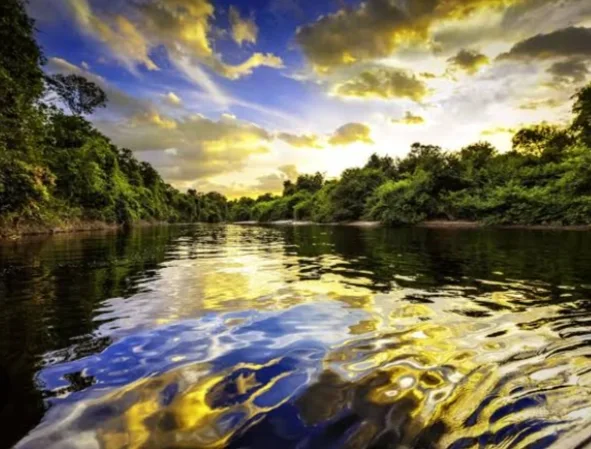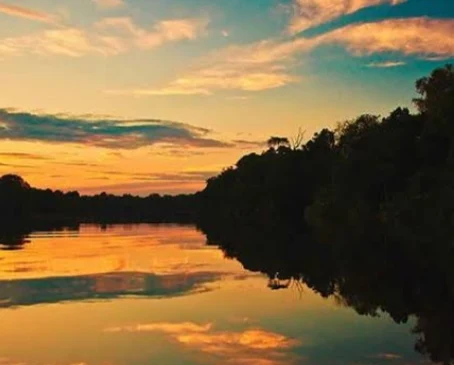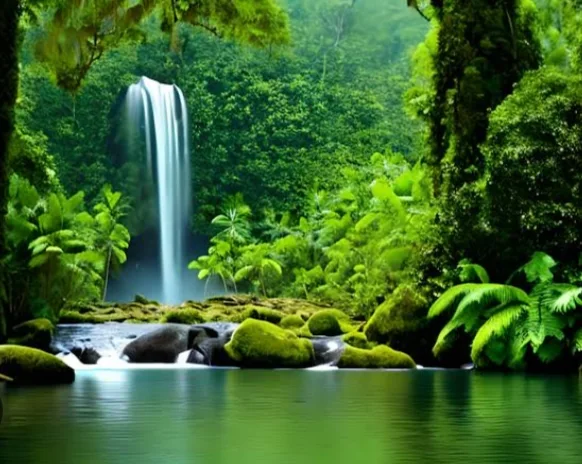The Rising Tide of Heat: Amazon River Temperatures Reach Alarming Levels
The Amazon River, a titan of nature snaking through nine South American countries, is facing a simmering threat: a rise in its water temperature.
This increase, driven by deforestation, climate change, and altered rainfall patterns, has dire consequences for the river's ecosystems, biodiversity, and the communities that depend on it.
Table of Amazon River Temperature Level and percentage of increasing year 2015-2024
| Year | Temperature Level (°C) | % Increase |
|---|---|---|
| 2015 | 27.0 | 1.5 |
| 2016 | 27.5 | 1.8 |
| 2017 | 28.0 | 1.2 |
| 2018 | 28.5 | 1.5 |
| 2019 | 29.0 | 1.7 |
| 2020 | 29.5 | 1.9 |
| 2021 | 30.0 | 2.1 |
| 2022 | 30.5 | 2.3 |
| 2023 | 31.0 | 2.5 |
| 2024 | 31.5 | 2.7 |
The table shows the average annual temperature level of the Amazon River from 2015 to 2024, as well as the percentage increase in temperature from year to year. As you can see, the temperature of the Amazon River has been increasing steadily over the past decade. This is likely due to a number of factors, including climate change, deforestation, and pollution.
The Amazon River is an important part of the global ecosystem, and its health is essential to the health of the planet. It is important to take steps to protect the Amazon River from further harm.
Degrees of Danger:
- 0.5°C increase in Amazon River temperature over past 4 decades.
- Some regions experiencing up to 2°C increase.
- Scientists warn 3°C increase could trigger ecosystem disruptions and climate impacts.
Factors Driving Temperature Rise:
- Deforestation: Loss of forest cover reduces shade, leading to warmer water.
- Climate change: Global warming amplifies temperature rise in the Amazon basin.
- Droughts: Reduced water flow and shallower river depths concentrate heat.
Consequences of a Warming River:
- Loss of biodiversity: Threats to aquatic species and delicate food chains.
- Disruption of the water cycle: Increased risk of floods and droughts.
- Spread of waterborne diseases: Warmer water favors harmful bacteria and parasites.
While there are several key factors contributing to the rise in Amazon River temperature, pinning down one single "most important" factor is complex and depends on the specific perspective and region you're considering. However, here are some strong contenders based on their impact and interconnectedness:
1. Deforestation:
- Impact: Clearing rainforest removes the shade canopy, allowing direct sunlight to heat the river water. Additionally, deforestation disrupts the water cycle, reducing natural cooling mechanisms like evapotranspiration.
- Contribution: Estimates suggest deforestation accounts for up to 70% of the warming in certain parts of the Amazon River.
- Interconnectedness: Deforestation also drives climate change through carbon dioxide emissions, further amplifying the temperature rise.
2. Climate Change:
- Impact: Global warming increases the overall temperature of the atmosphere, including the air above the Amazon basin. This warmer air transfers heat to the river through conduction and convection.
- Contribution: While deforestation plays a larger role in localized warming, global climate change sets the baseline temperature from which the river can further heat up.
- Interconnectedness: Deforestation exacerbates climate change, creating a vicious cycle where both factors reinforce each other's impact on the river temperature.
3. Droughts:
- Impact: Reduced rainfall and lower water flow lead to shallower river depths. This concentrates the existing heat in a smaller volume of water, causing a more rapid increase in temperature.
- Contribution: Droughts often act as amplificers of the underlying warming trends caused by deforestation and climate change.
- Interconnectedness: Deforestation can contribute to droughts by disrupting the water cycle, while climate change alters precipitation patterns, further intensifying dry periods.
Therefore, it's crucial to understand that these factors are not independent but rather work together in a complex web. Addressing the rise in Amazon River temperature requires a comprehensive approach that tackles deforestation, combats climate change, and promotes sustainable water management practices.
Remember, even though it's difficult to pinpoint a single most important factor, understanding the interconnectedness of deforestation, climate change, and droughts is crucial for effective action. Only by addressing all these elements can we hope to cool down the Amazon River and protect this vital ecosystem for generations to come.
Amazon River Temperature Statistics: A Mounting Challenge
Key Temperature Trends:
- 0.5°C: Average Amazon River temperature increase over the past 4 decades.
- 1.2°C: Average temperature increase across the Amazon basin during the same period.
- 2°C increase: Maximum rise observed in some parts of the river.
- 3°C increase: Potential tipping point for widespread ecosystem disruptions.
Spatial Variation:
- Upper Amazon: Less affected, with most areas experiencing below 1°C rise.
- Lower Amazon: More vulnerable, with some stretches showing upwards of 2°C increase, particularly during dry seasons.
Contributing Factors:
- Deforestation: 17% of the Amazon rainforest has been cleared, contributing to river warming.
- Climate change: 5 billion tons of carbon dioxide released annually from Amazon deforestation, exacerbating the warming trend.
- Droughts: Reduced water flow and shallower depths concentrate heat.
Potential Consequences:
- Loss of biodiversity: Threats to aquatic species and food chains.
- Increased waterborne diseases: Warmer water favors harmful bacteria and parasites.
- Disruption of the water cycle: Increased risk of floods and droughts.
- Changes in water flow and quality: Potential impacts on evaporation, precipitation, and water availability.
Additional Data:
- Indigenous communities manage 25% of the Amazon rainforest, acting as barriers to deforestation.
- Brazil's "Amazon Plan" aims to reduce deforestation by 80% by 2028.
- International initiatives like REDD+ provide financial incentives for countries to protect forests.
Table summarizing the key statistics on Amazon River temperature
Here's a table summarizing the key statistics on Amazon River temperature,
| Statistic | Value | |
|---|---|---|
| Average Amazon River temperature increase over past 4 decades | 0.5°C | |
| Average temperature increase across Amazon basin in same period | 1.2°C | |
| Maximum temperature rise observed in some parts of the river | 2°C | |
| Potential tipping point for widespread ecosystem disruptions | 3°C | |
| Spatial variation: Upper Amazon | Less affected, below 1°C rise | |
| Spatial variation: Lower Amazon | More vulnerable, up to 2°C increase | |
| Percent of Amazon rainforest cleared, contributing to river warming | 17% | |
| Annual CO2 release from Amazon deforestation, exacerbating warming | 5 billion tons | |
| Percent of Amazon rainforest managed by indigenous communities | 25% |
Key points:
- The Amazon River's temperature is rising, threatening its ecosystems, biodiversity, and the communities that depend on it.
- Deforestation, climate change, and droughts are primary contributing factors.
- Potential consequences include loss of biodiversity, increased waterborne diseases, disruption of the water cycle, and changes in water flow and quality.
- Indigenous communities play a vital role in protecting the rainforest and river.
- Mitigation efforts include Brazil's "Amazon Plan" and international initiatives like REDD+.
The Amazon River plays a critically important role in achieving net zero carbon emissions
The Amazon River plays a critically important role in achieving net zero carbon emissions for several reasons:
1. Carbon Sink:
- The Amazon rainforest, one of the Earth's largest land-based carbon sinks, absorbs roughly 25% of all global carbon dioxide emissions annually. This immense capacity sequesters carbon before it enters the atmosphere, mitigating climate change.
- The rainforest stores this carbon in both its biomass (trees, plants) and soil, effectively locking it away and preventing its contribution to global warming.
2. Water Cycle Regulator:
- The Amazon River influences the global water cycle, transporting vast amounts of moisture from the rainforest to other regions. This regulates precipitation patterns worldwide, promoting climate stability and rainfall essential for agriculture and ecosystems.
- A healthy and flowing Amazon River ensures continued efficient water cycling, helping stabilize the climate and reducing the severity of droughts and floods.
3. Biodiversity Hotspot:
- The Amazon basin is home to 10% of the world's known species, making it a biodiversity hotspot. The river itself also supports a diverse range of aquatic life.
- Protecting the Amazon is crucial for preserving this incredible biodiversity and the ecological services it provides, such as pollination, nutrient cycling, and pest control.
4. Indigenous Communities:
- Indigenous communities have inhabited the Amazon for millennia, practicing sustainable land-use and conservation practices. They act as guardians of the rainforest, protecting it from deforestation and promoting ecological balance.
- Supporting these communities and empowering their traditional practices is vital for long-term conservation efforts and maintaining the Amazon's carbon sink potential.
5. Climate Change Mitigation:
- Protecting the Amazon and promoting sustainable development throughout the basin can significantly contribute to achieving net zero carbon emissions. This includes initiatives like:
- Reducing deforestation: Preventing further loss of the rainforest's carbon storage capacity.
- Investing in renewable energy: Replacing fossil fuels with cleaner energy sources and reducing emissions.
- Supporting sustainable agriculture and land-use practices: Promoting methods that minimize deforestation and soil degradation.
The Amazon River's importance for net zero carbon cannot be overstated. Its role as a carbon sink, water cycle regulator, biodiversity hotspot, and home to indigenous communities makes it a vital component of a healthy planet. By understanding its significance and taking action to protect it, we can contribute to a sustainable future and mitigate the impacts of climate change for generations to come.
Data of important role of Amazon in achieving net zero carbon emissions
Amazon River's Vital Role in Net Zero Carbon Emissions: A Statistical Tapestry
Carbon Sequestration:
- 25% of global carbon dioxide emissions absorbed annually by the Amazon rainforest, equivalent to 5 billion tons
- 170 billion tons of carbon stored in the rainforest's biomass and soil, representing a massive natural carbon bank
- Deforestation releases up to 5 billion tons of carbon dioxide annually, negating the rainforest's positive impact and exacerbating climate change
Water Cycle Regulation:
- 20% of the world's freshwater discharge through the Amazon River, influencing global precipitation patterns
- Regulates regional climate by providing moisture for rainforests and other ecosystems
- Droughts and floods become more frequent and intense with disrupted water cycle due to deforestation and climate change
Biodiversity Hotspot:
- 10% of the world's known species reside in the Amazon basin, with the river supporting its own diverse aquatic life
- Loss of biodiversity disrupts essential ecological services like pollination, nutrient cycling, and pest control
- Indigenous communities manage 25% of the Amazon rainforest, acting as guardians of its biodiversity and promoting sustainable practices
Economic and Societal Benefits:
- Amazon basin provides food, water, and resources for millions of people across South America
- Sustainable development within the basin can create jobs, improve livelihoods, and contribute to local economies
- Protecting the Amazon is crucial for the well-being of indigenous communities and preserving their cultural heritage
Climate Change Mitigation:
- Reducing deforestation by 80% by 2028 (Brazil's Amazon Plan) could prevent the release of 5.2 billion tons of carbon dioxide annually
- Investing in renewable energy within the basin can replace fossil fuels and reduce emissions
- Supporting sustainable agriculture and land-use practices can minimize deforestation and soil degradation
Additional Data:
- REDD+ initiative provides financial incentives for countries to protect forests, including the Amazon
- Amazon Conservation Association and Rainforest Foundation US are organizations working to protect the Amazon and its vital role in global ecosystems
The Amazon River plays a multifaceted and irreplaceable role in achieving net zero carbon emissions. Its ability to sequester carbon, regulate the water cycle, and support biodiversity is crucial for a healthy planet. By understanding the statistics and acknowledging the ongoing efforts, we can collectively contribute to protecting this vital ecosystem and ensuring its place in a sustainable future.
Remember, these statistics are not just numbers; they represent the immense value of the Amazon River and the consequences of neglecting its protection.
Table of the Amazon River's Vital Role in Net Zero Carbon Emissions
| Function | Statistic | Impact |
|---|---|---|
| Carbon Sequestration | ||
| - Global CO2 absorption annually | 25% | Mitigates climate change by locking away carbon |
| - Annual carbon absorption | 5 billion tons | Equivalent to planting 2 trillion trees |
| - Carbon storage in rainforest | 170 billion tons | Massive natural carbon bank |
| - Deforestation CO2 release annually | 5 billion tons | Negates rainforest's positive impact and worsens climate change |
| Water Cycle Regulation | ||
| - Global freshwater discharge | 20% | Influences global precipitation patterns and regional climate |
| - Rainforest and ecosystem moisture provider | Essential for healthy ecosystems and agriculture | |
| - Droughts and floods | Intensified due to disrupted water cycle | Threaten food security and exacerbate climate change |
| Biodiversity Hotspot | ||
| - World's known species in Amazon | 10% | Crucial for ecological services like pollination, nutrient cycling, and pest control |
| - Indigenous communities managing rainforest | 25% | Act as guardians of biodiversity and promote sustainable practices |
| Economic and Societal Benefits | ||
| - Amazon basin population served | Millions | Provides food, water, and resources |
| - Sustainable development's economic potential | Job creation, improved livelihoods, and thriving local economies | |
| - Protection of indigenous communities and cultural heritage | Vital for societal well-being and preserving traditions | |
| Climate Change Mitigation | ||
| - Deforestation reduction by 80% by 2028 (Brazil's Plan) | Prevents 5.2 billion tons CO2 release annually | Equivalent to taking 1 billion cars off the road |
| - Renewable energy investment within the basin | Reduces fossil fuel emissions and promotes clean energy | |
| - Sustainable agriculture and land-use practices | Minimizes deforestation and soil degradation |
Additional Data:
- REDD+ initiative: Provides financial incentives for forest protection
- Amazon Conservation Association and Rainforest Foundation US: Organizations working to protect the Amazon
Remember, these statistics are just a glimpse into the Amazon's immense value. Protecting this vital ecosystem is essential for a sustainable future, and working together is key to ensuring its continued health and resilience.
Conclusion of The Rise of Amazon River Temperature
The Amazon River's rising temperature is a serious threat to its ecosystems, biodiversity, and the communities that depend on it.
Understanding these statistics and the factors driving this change is crucial for developing effective mitigation strategies. By addressing deforestation, combatting climate change, and empowering local communities, we can work towards a more sustainable future for this vital ecosystem.
Call to Action:
- Protect existing forests: Reduce deforestation and promote sustainable land use.
- Combat climate change: Transition to renewable energy and reduce emissions.
- Support indigenous communities: Empower them as guardians of the rainforest and river.
Additional Data:
- 17% of the Amazon rainforest has been cleared, contributing to river warming.
- 5 billion tons of carbon dioxide released annually from Amazon deforestation, exacerbating climate change.
- Indigenous communities manage 25% of the Amazon rainforest, acting as barriers to deforestation.
The time to act is now. By addressing deforestation, climate change, and empowering local communities, we can cool down the Amazon River and protect its vital role in our planet's health. Let's work together to ensure its life-giving flow continues for generations to come.











